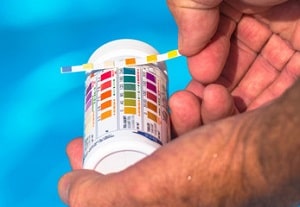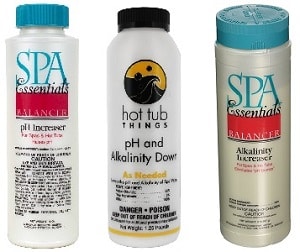
This is to ensure that the chemicals you have to add, which prevent the water harboring bacteria and algae, are at the correct levels. If they are, you can be sure that your inflatable hot tub is safe and hygienic for you and your family to use. As an added bonus, it also keeps the hot tub clean and helps to prolong its life.
If you look up any of the advice online about how to test the water in your portable hot tub, you’ll see there are a lot of confusing words: pH, ppm, alkalinity, and so on. It can all be very confusing. So we’ll try and make it a whole lot less scary.
The First Thing You Need To Know
Basically, when you test the water in your inflatable hot tub, you are checking the pH level.
If you’re like us, you might have a vague memory of test strips and pH levels from science lessons at school, but you can’t remember what it all means.
So, briefly, pH is a scale of numbers from 0 to 14 which are used to measure how acid or alkali a liquid is, such as hot tub water. If a liquid is acidic, it has a pH number anywhere from 0 to just under 7. If a liquid is alkaline – or what is nowadays known as basic – it will have a pH number of just above 7 to 14. Right in the middle of the scale is 7 (known as neutral), which is the pH value of pure water.
Here are the pH values of some everyday items, to help you get a clearer picture:
- battery acid: 0 (extremely acidic)
- lemon juice: 2
- beer: 4
- pure water: 7 (neutral)
- sea water: 8
- hand soap: 9
- bleach: 13
- drain cleaner: 14 (extremely alkaline)
If the water in your hot tub is very acidic, it will start destroying the hot tub and the working parts. It can also irritate your skin and make your eyes feel as if they’re burning. If the water is too alkaline, then it will dry your skin, ruin your swimwear, make your eyes red and itchy, and – very importantly – stop the chemicals from working that you add to your water to keep it hygienic.
So what you must always keep in mind is that the pH value of the water in your hot tub needs to be between 7.2 and 7.8. This means it must be slightly alkaline, just above neutral.
Therefore, you need to regularly test the pH level of the water in your inflatable hot tub, making sure it is within this range. If it is, then no problem. Your hot tub is ready to use.
If the pH level is too low or too high, however, you will need to alter it.
Let’s look at everything you need to do in more detail, from the beginning.
Testing The pH Of The Water
To start with, you need to test the pH value of the water in your hot tub. To do this, you’ll need a hot tub pH test strip such as the Poolmaster 4-Way Spa Test Strips which are always good and cheap.
To carry out the test, dip one of the strips into the water, and hold it about 6 inches below the surface of the water for a few seconds. Then take it out.
Now wait for 20 seconds, and you’ll see that the three different patches on the strip all change color.
The patch you will need to look at on the Poolmaster 4-Way Strips to see if the pH is okay, is the third patch down from the top of the strip. You can, of course, use other spa water testing strips, and the procedure is very similar to the Poolmaster ones.
The color of the pH patch on the test strip will change according to the pH of the water. You then hold the strip against the easy-to-read color scale on the back of the container your pH strips come in and compare the colors. This will show you if the water in your hot tub is too acidic, too basic, or just right.
As we saw, the pH level of your water should be between 7.2 and 7.8. If it is not within this range, you will need to adjust it.
Before you do that, however, you need to check the Total Alkalinity of the water.

The bottom patch shows the pH of the water. The middle patch shows the Total Alkalinity.
Testing The Total Alkalinity Of The Water
The key to altering the pH level of your inflatable hot tub water lies in what is called the Total Alkalinity (TA) of the water.
You don’t need to go into the chemistry of Total Alkalinity, other than to know that it is a chemical value of the water that allows you to control the pH level. However, if you are interested in learning more, there is an in-depth article over on the epa website on Total Alkalinity (opens in a new tab).
Basically, if the Total Alkalinity of hot tub water is too low, then the pH value will be unstable and can go up and down very easily. If the TA is too high, it will create a pH value that is also too high, which will make the water cloudy and create scale on the inner surfaces of the hot tub.
So if you need to adjust the pH of your hot tub water, then you need to make sure the Total Alkalinity is right to start with. Otherwise, you won’t be able to get the pH level right.
Therefore, if your pH level needs changing, before you do anything else, you need to test the Total Alkalinity level of your inflatable hot tub water, using TA test strips. Luckily, if you bought the Poolmaster test strips, they can also be used to test the TA of the water!
Again, you dip the strip into your hot tub, holding about 6 inches under the surface for a few seconds. When you take it out, wait 20 seconds, and hold the strip against the scale on the test strip container. This time you are looking at the middle patch on the test strip and checking against the Alkalinity (Alk) scale.
Ideally, the Total Alkalinity of your hot tub water should be between 80 and 120 parts per million (ppm).
If it is within this range, you can then adjust the pH level as required. If the TA is outside of this range, though, you first need to alter the TA level before you work on the pH level.
If this sounds confusing, then don’t worry! In the next section we have put together a table that gives you every possible scenario and exactly what to do for each one.
How To Change The pH And Total Alkalinity Of Your Inflatable Hot Tub Water
It can seem confusing to owners of inflatable hot tubs how to balance the Total Alkalinity and the pH levels of the water. That’s because there can be a number of variations. So, as promised, here’s everything you need to know in its simplest form.
| Problem | What you need to do |
| Low pH, Normal TA | Add a pH increaser that does not affect the TA. |
| Low pH, High TA | Add a pH decreaser to lower the TA levels. Then add a pH increaser that doesn't affect the TA level. |
| Low pH, Low TA | Add a pH increaser to raise the level of both. |
| High pH, High TA | Add a pH decreaser to bring the levels of both the pH and TA down. |
| High pH, Normal TA | Add a pH decreaser to lower the pH level to normal. |
| High pH, Low TA | Add a pH decreaser to lower the pH level. Then add an alkaline increaser to raise the TA level. |
| Normal pH, High TA | Add a pH decreaser to lower the TA level. |
| Normal pH, Low TA | Add an alkaline increaser to raise the TA level. |

A pH increaser, a pH and Alkalinity decreaser, and an Alkalinity increaser will cover every variation.
Don’t Worry
While all of this may sound difficult, you’ll quickly find that it is easier than you think.
The key is to carry out regular pH level checks, and keep your pH and TA levels at acceptable levels. Just a few minutes once a week doing this, and you and your family will have hours of fun enjoying the clean, safe, sparkly waters of your inflatable hot tub.
And if you do need to change the balance of your water, then always refer to our table above and you’ll get it right!
Remember: you should be spending more time enjoying your inflatable hot tub than working on it.
Now that you know How To Test The Water In Your Inflatable Hot Tub, you might like to check out our article on Your Guide To Inflatable Hot Tub Chemicals. Thanks for reading!
Recommended Reading
How To Shock Your Inflatable Hot Tub
Why You Mustn’t Pee In Your Inflatable Hot Tub
